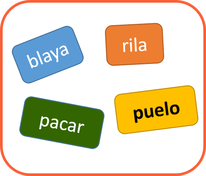 Are you thinking I am going to talk about the way students "make up words" with their spellings? Well, I am not. First, because I do not believe students make up words when they make spelling errors, but they are really trying to spell real ones. What I want to talk about is made-up words that are made up... by teachers, known as pseudo-words. Pseudo-words are made-up words that look like real words in a certain language. Pseudo-words in English could be brike, loke, fiper, or dight. They do not exist as words in English, but they are pronounceable and follow patterns found in real English words, such as bride, poke, fiber, and light. Pseudo-words like blaya, rila, pacar, or puelo are nonexistent but possible words in Spanish (similar to playa, pila, rima, picar, and suelo). Pseudo-words have a space in the language classroom. Let’s see one example today. Let’s say you want students to learn the writing of the GUE, GUI sequences, vs. the writing of GE, GI. If you only use examples like “guerra” and “gente,” it is very likely students will read and spell those words right, giving the impression that they are perfectly aware of the contrast ge/gue. However, they will read and write them right because they already know those words. When students read them, they do not need to pay attention to the exact sequence of letters, because they simply recognize the words. And when students write them, they will probably spell them right because they have seen them before. However, when they need to write less familiar words, they will make errors like llege, lleguo, … If we want students to pay attention to the orthographic contrast (GE - GUE) so that this orthographic sequence is applied to ALL words (familiar, infrequent, and new words), you can use pseudo-words. For example, students can be asked to read these words: guelo - laguifa - gipar – lugueto – piguenar – pegifante – pogé Because students have never heard those words before, they cannot use the “recognition strategy,” that is, recognize the word and just say it as they know it is pronounced. They really need to pay attention to that orthographic pattern. You can also use these pseudo-words in dictation: you read them and students write them. I would add two more benefits of using pseudo-words in the class, in addition to the main benefit of directing students' attention to the specific orthographic aspect: 1) It is fun! Working with made-up words adds a playful element to the lesson. 2) It helps lessen the fear to unknown words. The presence of an unknown word in a sentence creates an uncomfortable feeling to some students, which makes them sort of freeze and not be able to understand anything else in the sentence. The first time I work with pseudo-words in a classroom, some students laugh nervously. But working with these made-up words helps those students to get used to encountering unknown words. (With the idea that when those unknown words are real, their lack of fear will allow them to work on context clues and vocabulary-increasing activities). Now, although the use of pseudo-words has its benefits in the classroom, it should be limited, and applied only on specific occasions with a specific purpose. A very important component of spelling is visual memory. After reading and writing a word many times, for years, that word gets engraved in our memory, and we do not need to think about the rules to write it. Therefore, students should spend most of their time writing real words, which are the ones that should get engraved in the students’ mental visual dictionary. Likewise, there is nothing wrong with reading using a “recognition strategy”. This is what allows us to read fast and fluently, and to focus on comprehension of texts. Therefore, teachers should focus on increasing students’ vocabulary, through reading and talking about a variety of topics in a variety of genres, registers, and styles. In future posts I will give other ideas for using pseudo-words in the classroom… in a timely manner. *********************** Have you encountered any interesting spelling error (frequent or not) you would like me to write about? Feel free to let me know in a comment.
0 Comments
Leave a Reply. |
BLOG ON SPELLING
This is a blog about spelling in Spanish Heritage Language Learners. Some posts will be in Spanish and some in English. Feel free to ask your questions in the comments section.
Archives
September 2023
Popular Posts
Made-up words and other fipers. Tips for teaching stress marks. Los hablantes nativos y la ortografía |

